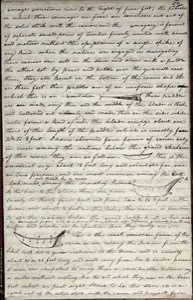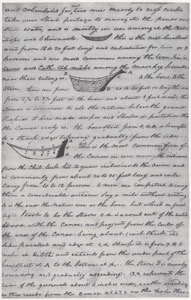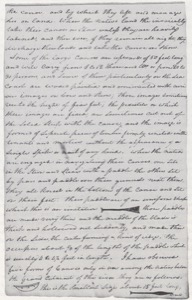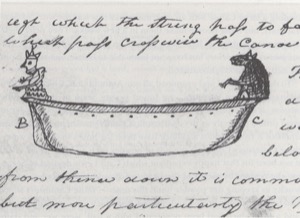February 1, 1806
[Lewis]
This morning a party of four men set out with Joseph Fields; Sergt. Gass with a party of five men again set out up the Netul river in surch of the Elk which had been killed some days since, and which could not be found in consequence of the snow. The Canoes of the naives inhabiting the lower portion of the Columbia River make their canoes remarkably neat light and well addapted for riding high waves. I have seen the natives near the coast riding waves in these canoes with safety and apparently without concern where I should have thought it impossible for any vessel of the same size to lived a minute. they are built of whitecedar or Arborvita generally, but sometimes of the firr. they are cut out of a solid stick of timber, the gunwals at the upper edge foald over outwards and are about ⅝ of an inch thick and 4 or five broad, and stand horrizontally forming a kind of rim to the canoe to prevent the water beating into it. they are all furnished with more or less crossbars in proportion to the size of the canoe. these bars are round sticks about half the size of a man's arm, which are incerted through holes 〈just〉 made in either side of the canoe just below the rim of the gunwall and are further secured with strings of waytape; [1] these crossbars serve to lift and manage the canoe on land. when the natives land they invariably take their canoes on shore, unless they are heavily laden, and then even, if they remain all night, they discharge their loads and take the canoes on shore. some of the large canoes are upwards of 50 feet long and will carry from 8 to 10 thousand lbs. or from 20 to thirty persons and some of them particularly on the sea coast are waxed painted and ornimented with curious images at bough and Stern; those images sometimes rise to the hight of five feet; the pedestals on which these immages are fixed are sometimes cut out of the solid stick with the canoe, and the imagary is formed of seperate small peices of timber firmly united with tenants and motices without assistance of a single spike of any kind. when the natives are engaged in navigating their canoes one sets in the stern and steers with a paddle the others set by pears and paddle over the gunwall next them, they all kneel in the bottom of the canoe and set on their feet. their paddles are of a uniform shape of which this is an imitation [2] these paddles are made very thin and the middle of the blade is thick and hollowed out siddonly and made thin at the sides while the center forms a kind of rib. the blade occupys about one third of the length of the paddle which is usually from 4½ to 5 feet. I have observed four forms of canoe only in uce among the nations below the grand chatarac of this river they are as follows. this is the smallest size [3] about 15 feet long and calculated for one or two persons, and are most common among the Cathlahmahs and Wâck ki a cums among the marshey Islands. A the bow; B, the stern; these [4] are from twenty to thirty five feet and from two ½ to 3 feet in the beam and about 2 feet in the hole; this canoe is common to all the nations below the grand rappids. it is here made deeper and shorter in proportion than they really are.— the bowsprit from C, to D is brought to a sharp edge tapering gradually from the sides.
This is the most common form [5] of the canoe in uce among the Indians from; the Chil-luck-kit-te-quaw inclusive to the Ocean and is usually about 30 or 35 feet long, and will carry from ten to twelve persons. 4 men are competent to carry them a considerable distance say a mile without resting. A is the end which they use as the bow, but which on first sight I took to be the stern C. D. is a comb cut of the sollid stick with the canoe and projects from the center of the end of the canoe being about 1 inch thirck it's sides parallel and edge at C D. sharp. it is from 9 to 11 Inches in length and extends from the underpart of the bowsprit at A to the bottom of the canoe at D.— the stern B. is mearly rounding and graduly ascending. 1 2 3 represents the rim of the gunwalls about 4 Inches wide, reather ascending as they recede from the canoe. 4 5 6 7 8 are the round holes through which the cross bars are inserted.—
and Most Common Canoe, February 1, 1806, Codex J, p. 52
This form of canoe [6] we did not meet with untill we reached tidewater or below the grand rappids. from thence down it is common to all the nations but more particularly the Killamucks and others of the coast. these are the largest canoes. B. is the bow and comb. C. the stern and comb. their immages are representations of a great variety of grotesque figures, any of which might be safely worshiped without committing a breach of the commandments. [7]
They have but few axes among them, and the only too usually imployed in felling the trees or forming the canoe, carving &c is a chiseel formed of an old file about an Inch or an Inch and a half broad. this chissel has sometimes a large block of wood for a handle; they grasp the chissel just below the block with the right hand holding the edge down while with the left they take hold of the top of the block and strick backhanded against the wood with the edge of the chissel. [8] a person would suppose that the forming of a large canoe with an instrument like this was the work of several years; but these people make them in a few weeks. they prize their canoes very highly; we have been anxious to obtain some of them, for our journey up the river but have not been able to obtain one as yet from the natives in this neighbourhood.— today we opened and examined all our ammunition, which had been secured in leaden canesters. we found twenty seven of the best rifle powder, 4 of common rifle, three of glaized and one of the musqut powder in good order, [9] perfectly as dry as when first put in the canesters, altho' the whole of it from various accedents has been for hours under the water. these cannesters contain four lbds. of powder each and 〈contain〉 8 of lead. had it not have been for that happy expedient which I devised of securing the powder by means of the lead, we should not have had a single charge of powder at this time. three of the canesters which had been accedentally bruized and cracked, one which was carelessly stoped, and a fifth that had been penetrated with a nail, were a little dammaged; these we gave to the men stock to last us back; and we always take care to put a proportion of it in each canoe, to the end that should one canoe or more be lost we should still not be entirely bereft of ammunition, which is now our only hope for subsistence and defence in a rout of 4000 miles through a country exclusively inhabited by savages.—
[Clark]
This morning a party of four men Set out with Jo. Field; and Sergt. Gass with a party of five men again Set out up the Netul river in Serch of the Elk which had been killed Some days since, and which Could not be found in Consequence of the Snow.
The Canoes of the nativs inhabitting the lower part of the Columbia River from the Long narrows down make their canoes remarkably neat light and well addapted for rideing high waves. I have Seen the nativs near the Coast rideing waves in these Canoes in Safty and appearantly without Concern when I Should it impossible for any vessel of the Same Size to have lived or kept above water a minute. they are built of Arborvitia or white Cedar generally, but Sometimes of fir. they are cut out of a solid Stick of timber, the gunnals at the upper edge fold over outwards and are about ⅝ of an inch thick and 4 or 5 broad, and Stand out nearly Horizontially forming a kind of rim to the Canoe to prevent the water beating into it. they are all furnished with more or less Cross bars agreeably to thier sizes of the Canoe, those bars are round Sticks about 1 inch and ½ diameter which are atached to the iner Side of the canoes a little below the rim on either Side with throngs of Cedar bark which is incerted through holes and made fast to the ends of the Stick, which is made Smaller than the other part of the stick to prevent the cord Slipping off these cross bears Serve to Strengthen the canoe, and by which they lift and manage her on land. when the nativs land the[y] invariably take their Canoes on Shore unless they are heavily ladined, and then even, if they remain all night, they discharge their loads and take the Canoe on Shore.
Some of the large Canoes are upwards of 50 feet long and will Carry from 8 to 12 thousand lbs. or from 20 to 30 persons, and Some of them particularly on the Sea Coast are waxed painted and ornimented with curious images on bow and Stern; those images sometimes rise to the hight of five feet; the pedestile on which these images are fixed, are Sometimes cut out of the Solid Stick with the Canoe, and the image is formed of Seperate pieces of timber firmly united with tenants and mortices without the appearance of a Single Spike or nail of any kind. when the nativs are engaged in navigateing their Canoes, one Sets in the Stern and Stears with a paddle the others Set by pars and paddle over their gunnals next them, they all kneel in the bottom of the Canoe and Set on their feet. their paddles are of an uniform shape which this is an imitation [10] those paddles are made verry thin and the middle of the blade is thick and hollowed out Suddenly, and made thin on the Sides, the center forming a kind of ridge. the [handle] occupies about ⅓ of the length of the paddle which is usually 4 to 4½ feet in length. I have observed five forms of Canoes only in use among the nativs below the Grand Cataract of this river. they are as follows. [11] this is the Smallest Size about 15 feet long, [12] and Calculated for one two men mearly to cross creeks, take over Short portages to navagate the ponds and Still water, and is mostly in use amongst the Clatsops and Chinnooks. [13] this is the next Smallest and from 16 to 20 feet long and calculated for two or 3 persons and are most Islands, near their villages. [14] A the bow; B the stern; those are from 20 to 40 feet in length and from 2½ to 3½ feet in the beam and about 2 feet deep; this Canoe is common to all the nations below the grand Rapids it here made deeper and Shorter in pertotion than the canoe realy is, the bow sprit from C. to D. is brought to a Sharp edge tapering gradually from the Sides. [15] This is the most common form of the Canoes in use among the indians from the Chil-luck-kit-te quaw inclusive to the ocian and is commonly from about 30 to 35 feet long, and will carry from 10 to 12 persons. 4 men are competent to carry them a considerable distance Say a mile without resting. A is the end the nativs use as the bow, but which on first Sight I took to be the Stern c. d. is a comb cut of the solid wood with the Canoe, and projects from the Center of the end of the Canoe being about 1 inch thick, it's Sides parallel and edge at c, d, Sharp it is from 9 to 11 inches in debth and extends from the under part of the bow sprit at A to the bottom at, d,. the Stern B is nearly rounding and gradually assending. 1, 2, 3, represents the rim of the gunnals about 4 inches wide, reather ascending as they recede from the Canoe. 4, 5, 6, 7, 8, are the holes through which the String pass to fasten the round pieces which pass Crosswise the Canoe to Strengthen & lift her. [16] This form of a canoe we did not meet with untill we reached tide water or below the Great Rapids. from thence down it is common to all the nations but more particularly the Kil a mox and others of the Coast. these are the largest Canoes, I measured one at the Kilamox villag S S W of us which was [blank] feet long [blank] feet wide and [blank] feet deep, and they are most Commonly about that Size. B is the bow, and Comb. C, the stern and Comb. Their images are representations of a great variety of grotesque figures, any of which might be Safely worshiped without commiting a breach of the Commandments.
February 1, 1806, Voorhis No. 2
Most Common Canoe, February 1, 1806, Voorhis No. 2
They have but fiew axes among them, and the only tool usially employd in forming the Canoe, carveing &c is a chiseel formed of an old file about an inch of 1½ inchs broad, this chissel has Sometimes a large block of wood for a handle; they grasp the chissel just below he block with the right hand holding the top of the block, and strikes backwards against the wood with the edge of the Chissel. a person would Suppose that forming a large Canoe with an enstriment like this was the work of several years; but those people make them in a fiew weeks. They prize their Canoes very highly; we have been anxious to obtain Some of them, for our journy up the river but have not been able to obtain one as yet from the nativs in this neighbourhood.
To day we opened and examined all our Ammunition, which has been Secured in leaden Canistirs. we found twenty Sevin of the best Rifle powder, 4 of Common rifle, 3 of Glaize and one of Musquet powder in good order, perfectly as dry as when first put in the Canisters, altho the whole of it from various accidince have been for hours under the water. these Cannisters Contain 4 pounds of powder each and 8 of Lead. had it not been for that happy expedient which Capt Lewis devised of securing the powder by means of the Lead, we Should have found great dificuelty in keeping dry powder untill this time—; those Cannisters which had been acidently brused and cracked, one which was carelessly Stoped, and a fifth which had been penetrated with a nail; were wet and damaged; those we gave to the men to Dry; however exclusive of those 5 we have an abundant Stock to last us back; and we always take Care to put a purpotion of it in each canoe, to the end that Should one Canoe or more be lost we Should Still not be entirely bereft of ammunition, which is now our only hope for Subsistance and defences in the rout of 4,000 miles through a Country exclusively inhabited by Indians—many bands of which are Savage in every Sense of the word—.
[Ordway]
Saturday 1st February 1806. a clear cold morning. Sergt. Gass and five more of the party Set out a hunting, and 4 men Set out with a hunter [17] to help with the meat to the Salt works.
[Gass]
Saturday 1st Feb. 1806. We had a fine clear cold morning. A number of the men [18] went out to bring meat to the fort, and to take some to the saltworks. [19]
[Whitehouse]
Saturday Febry 1st A clear cold morning. Serjeant Gass & five of our Men left the fort to go on a hunting party, four Men also left the fort with the hunter, [20] in order to help him to carry the meat of the 2 Elk he had killed to the Salt Camp.—







